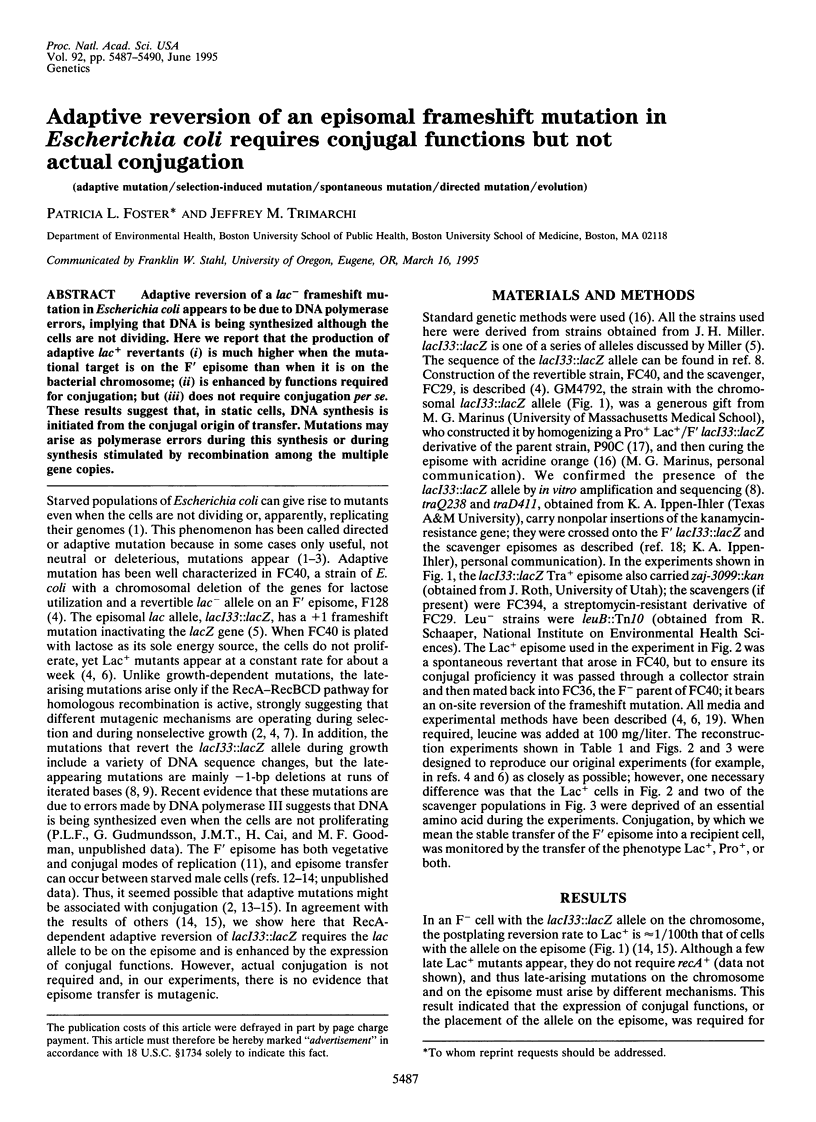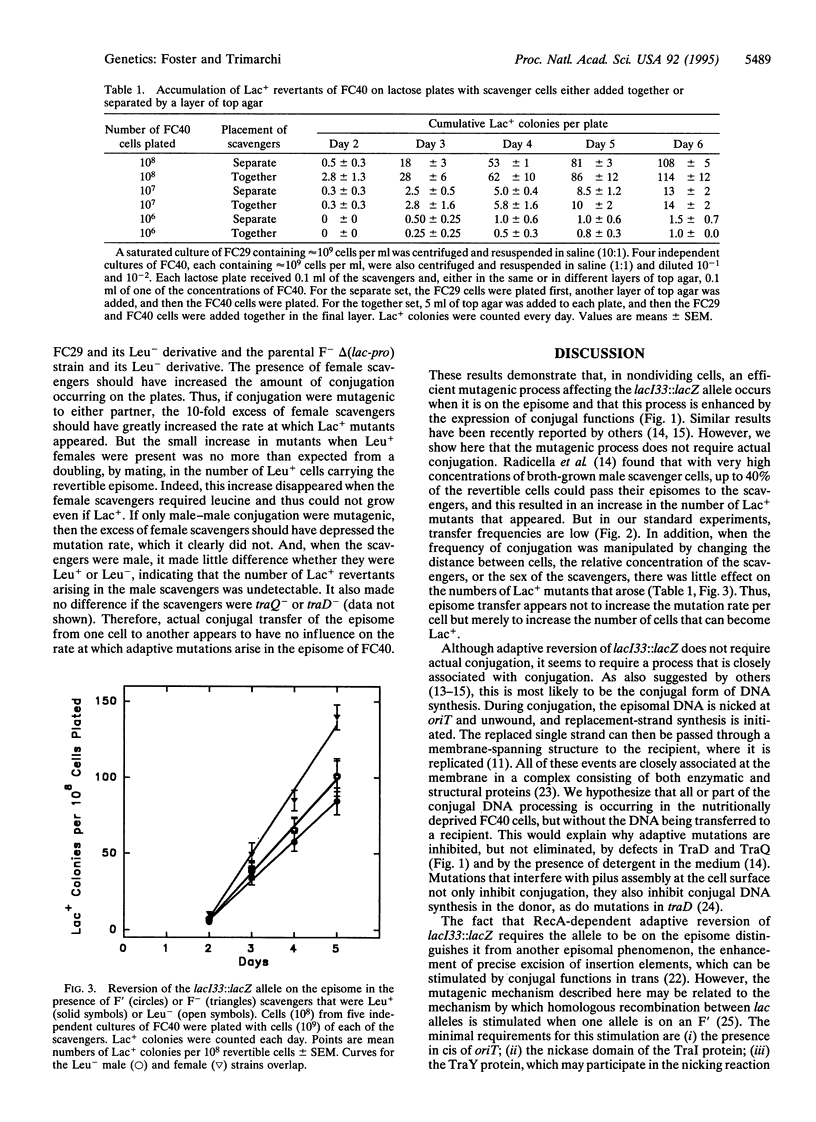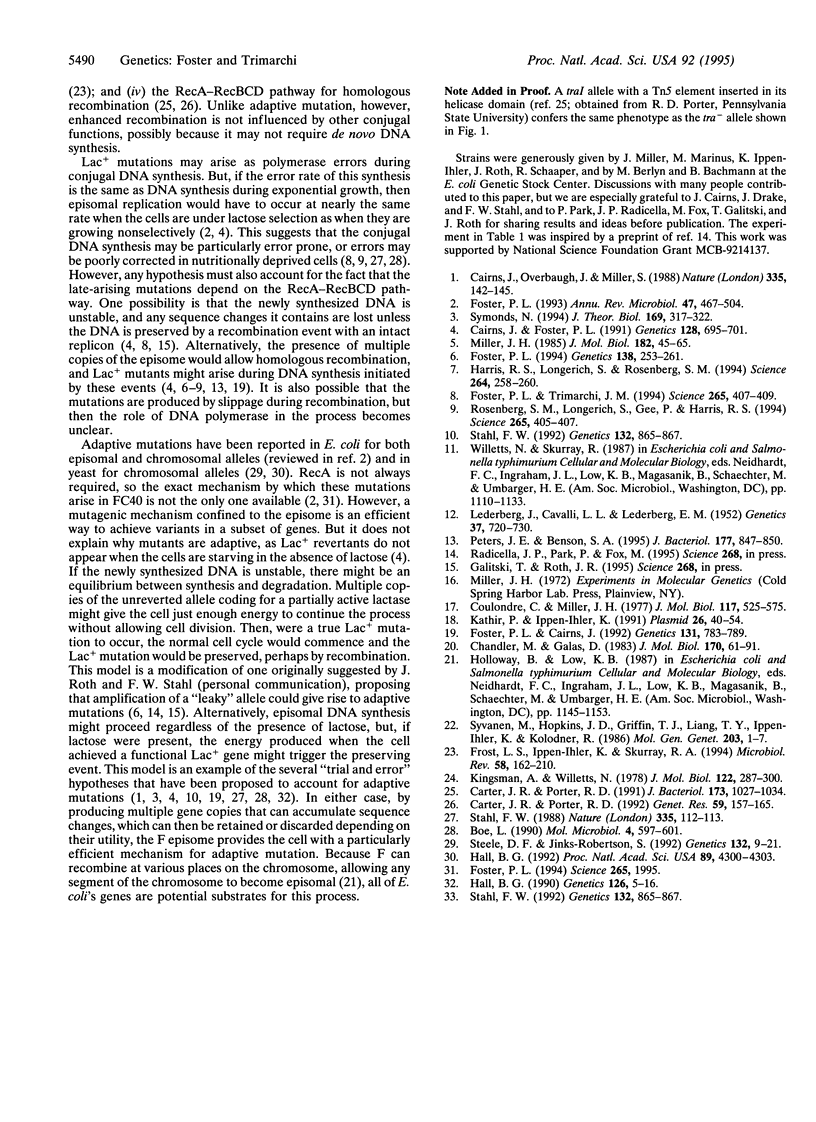Abstract
Adaptive reversion of a lac- frameshift mutation in Escherichia coli appears to be due to DNA polymerase errors, implying that DNA is being synthesized although the cells are not dividing. Here we report that the production of adaptive lac+ revertants (i) is much higher when the mutational target is on the F' episome than when it is on the bacterial chromosome; (ii) is enhanced by functions required for conjugation; but (iii) does not require conjugation per se. These results suggest that, in static cells, DNA synthesis is initiated from the conjugal origin of transfer. Mutations may arise as polymerase errors during this synthesis or during synthesis stimulated by recombination among the multiple gene copies.
Full text
PDF



Selected References
These references are in PubMed. This may not be the complete list of references from this article.
- Boe L. Mechanism for induction of adaptive mutations in Escherichia coli. Mol Microbiol. 1990 Apr;4(4):597–601. doi: 10.1111/j.1365-2958.1990.tb00628.x. [DOI] [PubMed] [Google Scholar]
- Cairns J., Foster P. L. Adaptive reversion of a frameshift mutation in Escherichia coli. Genetics. 1991 Aug;128(4):695–701. doi: 10.1093/genetics/128.4.695. [DOI] [PMC free article] [PubMed] [Google Scholar]
- Cairns J., Overbaugh J., Miller S. The origin of mutants. Nature. 1988 Sep 8;335(6186):142–145. doi: 10.1038/335142a0. [DOI] [PubMed] [Google Scholar]
- Carter J. R., Patel D. R., Porter R. D. The role of oriT in tra-dependent enhanced recombination between mini-F-lac-oriT and lambda plac5. Genet Res. 1992 Jun;59(3):157–165. doi: 10.1017/s0016672300030433. [DOI] [PubMed] [Google Scholar]
- Carter J. R., Porter R. D. traY and traI are required for oriT-dependent enhanced recombination between lac-containing plasmids and lambda plac5. J Bacteriol. 1991 Feb;173(3):1027–1034. doi: 10.1128/jb.173.3.1027-1034.1991. [DOI] [PMC free article] [PubMed] [Google Scholar]
- Chandler M., Galas D. J. Cointegrate formation mediated by Tn9. II. Activity of IS1 is modulated by external DNA sequences. J Mol Biol. 1983 Oct 15;170(1):61–91. doi: 10.1016/s0022-2836(83)80227-7. [DOI] [PubMed] [Google Scholar]
- Coulondre C., Miller J. H. Genetic studies of the lac repressor. III. Additional correlation of mutational sites with specific amino acid residues. J Mol Biol. 1977 Dec 15;117(3):525–567. doi: 10.1016/0022-2836(77)90056-0. [DOI] [PubMed] [Google Scholar]
- Foster P. L. Adaptive mutation. Science. 1994 Sep 30;265(5181):1995–1996. doi: 10.1126/science.8091219. [DOI] [PubMed] [Google Scholar]
- Foster P. L. Adaptive mutation: the uses of adversity. Annu Rev Microbiol. 1993;47:467–504. doi: 10.1146/annurev.mi.47.100193.002343. [DOI] [PMC free article] [PubMed] [Google Scholar]
- Foster P. L., Cairns J. Mechanisms of directed mutation. Genetics. 1992 Aug;131(4):783–789. doi: 10.1093/genetics/131.4.783. [DOI] [PMC free article] [PubMed] [Google Scholar]
- Foster P. L. Population dynamics of a Lac- strain of Escherichia coli during selection for lactose utilization. Genetics. 1994 Oct;138(2):253–261. doi: 10.1093/genetics/138.2.253. [DOI] [PMC free article] [PubMed] [Google Scholar]
- Foster P. L., Trimarchi J. M. Adaptive reversion of a frameshift mutation in Escherichia coli by simple base deletions in homopolymeric runs. Science. 1994 Jul 15;265(5170):407–409. doi: 10.1126/science.8023164. [DOI] [PMC free article] [PubMed] [Google Scholar]
- Frost L. S., Ippen-Ihler K., Skurray R. A. Analysis of the sequence and gene products of the transfer region of the F sex factor. Microbiol Rev. 1994 Jun;58(2):162–210. doi: 10.1128/mr.58.2.162-210.1994. [DOI] [PMC free article] [PubMed] [Google Scholar]
- Hall B. G. Selection-induced mutations occur in yeast. Proc Natl Acad Sci U S A. 1992 May 15;89(10):4300–4303. doi: 10.1073/pnas.89.10.4300. [DOI] [PMC free article] [PubMed] [Google Scholar]
- Hall B. G. Spontaneous point mutations that occur more often when advantageous than when neutral. Genetics. 1990 Sep;126(1):5–16. doi: 10.1093/genetics/126.1.5. [DOI] [PMC free article] [PubMed] [Google Scholar]
- Harris R. S., Longerich S., Rosenberg S. M. Recombination in adaptive mutation. Science. 1994 Apr 8;264(5156):258–260. doi: 10.1126/science.8146657. [DOI] [PubMed] [Google Scholar]
- Kathir P., Ippen-Ihler K. Construction and characterization of derivatives carrying insertion mutations in F plasmid transfer region genes, trbA, artA, traQ, and trbB. Plasmid. 1991 Jul;26(1):40–54. doi: 10.1016/0147-619x(91)90035-u. [DOI] [PubMed] [Google Scholar]
- Kingsman A., Willetts N. The requirements for conjugal DNA synthesis in the donor strain during flac transfer. J Mol Biol. 1978 Jul 5;122(3):287–300. doi: 10.1016/0022-2836(78)90191-2. [DOI] [PubMed] [Google Scholar]
- Lederberg J, Cavalli L L, Lederberg E M. Sex Compatibility in Escherichia Coli. Genetics. 1952 Nov;37(6):720–730. doi: 10.1093/genetics/37.6.720. [DOI] [PMC free article] [PubMed] [Google Scholar]
- Miller J. H. Mutagenic specificity of ultraviolet light. J Mol Biol. 1985 Mar 5;182(1):45–65. doi: 10.1016/0022-2836(85)90026-9. [DOI] [PubMed] [Google Scholar]
- Peters J. E., Benson S. A. Redundant transfer of F' plasmids occurs between Escherichia coli cells during nonlethal selections. J Bacteriol. 1995 Feb;177(3):847–850. doi: 10.1128/jb.177.3.847-850.1995. [DOI] [PMC free article] [PubMed] [Google Scholar]
- Rosenberg S. M., Longerich S., Gee P., Harris R. S. Adaptive mutation by deletions in small mononucleotide repeats. Science. 1994 Jul 15;265(5170):405–407. doi: 10.1126/science.8023163. [DOI] [PubMed] [Google Scholar]
- Stahl F. W. Bacterial genetics. A unicorn in the garden. Nature. 1988 Sep 8;335(6186):112–113. doi: 10.1038/335112a0. [DOI] [PubMed] [Google Scholar]
- Stahl F. W. Unicorns revisited. Genetics. 1992 Dec;132(4):865–867. doi: 10.1093/genetics/132.4.865. [DOI] [PMC free article] [PubMed] [Google Scholar]
- Stahl F. W. Unicorns revisited. Genetics. 1992 Dec;132(4):865–867. doi: 10.1093/genetics/132.4.865. [DOI] [PMC free article] [PubMed] [Google Scholar]
- Steele D. F., Jinks-Robertson S. An examination of adaptive reversion in Saccharomyces cerevisiae. Genetics. 1992 Sep;132(1):9–21. doi: 10.1093/genetics/132.1.9. [DOI] [PMC free article] [PubMed] [Google Scholar]
- Symonds N. Directed mutation: a current perspective. J Theor Biol. 1994 Aug 21;169(4):317–322. doi: 10.1006/jtbi.1994.1153. [DOI] [PubMed] [Google Scholar]


